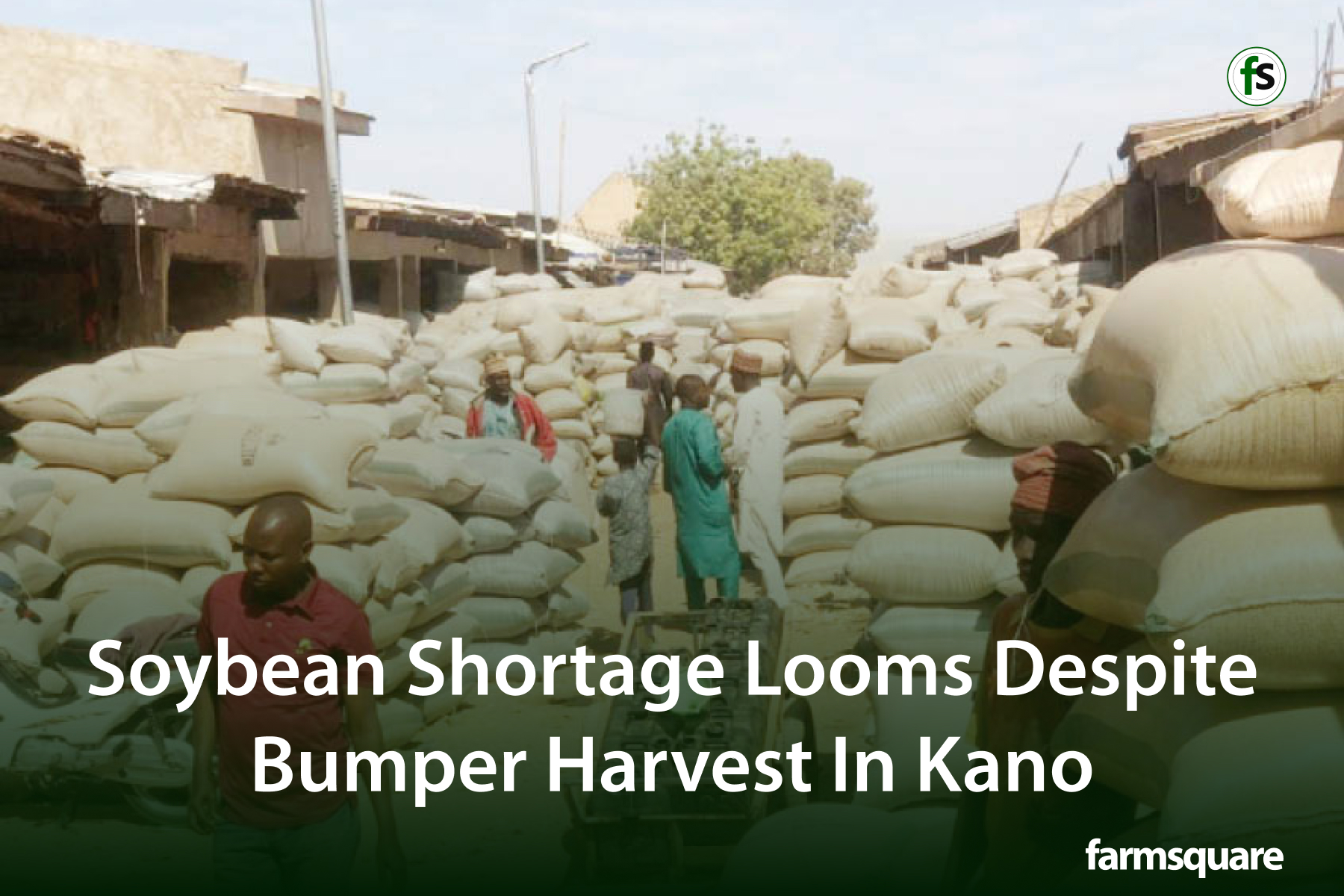Addressing China's Soybean Shortage: Sinograin's Auction Strategy

Table of Contents
Understanding the Scale of China's Soybean Shortage
China's demand for soybeans is astronomical. The country is the world's largest importer of soybeans, primarily due to the soaring demand for soy-based products and animal feed. This surge in demand is driven by several factors:
- Rising domestic demand for soy-based products: The consumption of soy milk, tofu, and other soy-derived foods continues to increase, reflecting changing dietary habits and growing health consciousness.
- Increased demand for animal feed: China's expanding livestock sector requires massive quantities of soybeans for animal feed, further fueling the demand.
- Dependence on major exporting countries: China heavily relies on imports from countries like Brazil and the US, making it susceptible to global supply chain disruptions and geopolitical events.
- Price fluctuations in the international soybean market: Global soybean prices are highly volatile, impacting the cost of soy-based products and animal feed in China, potentially affecting food affordability and accessibility.
This gap between domestic production and consumption necessitates a robust import strategy, making effective management of soybean procurement and distribution paramount to maintaining China's food security.
Sinograin's Role in Soybean Procurement and Distribution
Sinograin, the state-owned enterprise responsible for China's national grain reserves, plays a pivotal role in managing the soybean supply chain. Its responsibilities extend to:
- Managing strategic soybean reserves: Sinograin maintains substantial strategic reserves, acting as a buffer against market fluctuations and ensuring a stable supply even during periods of global scarcity.
- Direct procurement from domestic farmers and international suppliers: Sinograin procures soybeans both domestically and internationally, leveraging its extensive network to secure sufficient quantities to meet national needs.
- Effective distribution network: Its sophisticated distribution network ensures that soybeans reach processors and consumers across China, minimizing regional disparities and ensuring equitable access.
- Government policy influence: Sinograin's operations are deeply intertwined with government policies aimed at securing China's food security and stabilizing the agricultural sector.
Sinograin's actions significantly impact the domestic soybean market, influencing prices and supply availability.
Analyzing Sinograin's Auction Strategy for Soybean Management
Sinograin employs a strategic auction system to manage soybean supply and price. This system is designed to:
- Enhance transparency: The auctions aim to provide a transparent mechanism for soybean procurement, allowing various participants to compete fairly.
- Promote market efficiency: The competitive bidding process helps to discover market-clearing prices, reflecting the true value of soybeans.
- Ensure fair distribution: The auctions allow for a broader distribution of soybeans to various processors and consumers.
However, the system also faces challenges:
- Frequency and scale of auctions: The frequency and scale of auctions must be carefully calibrated to avoid market disruptions.
- Transparency and accessibility: Ensuring complete transparency and accessibility of the auction process for all participants is crucial for building trust and ensuring fairness.
- Potential for manipulation: Measures must be in place to prevent manipulation or collusion that could distort market prices.
Sinograin's auction strategy represents a key component of its broader effort to manage the China soybean shortage. The success of this strategy relies on its effectiveness in striking a balance between market mechanisms and government intervention.
The Impact of Sinograin's Strategy on Food Security and the Economy
Sinograin's auction strategy has had a notable impact on China's food security and the economy:
- Impact on consumer prices: The strategy has helped to stabilize domestic soybean prices, making soy-based products more affordable for consumers.
- Effect on domestic soybean farmers: The strategy provides a reliable market for domestic soybean farmers, encouraging domestic production.
- Contribution to national food security: By securing a stable supply of soybeans, Sinograin's strategy contributes significantly to China's food security.
- Economic stability: A stable supply of soybeans helps maintain stability in the broader food processing and livestock industries.
However, long-term sustainability depends on factors such as global market volatility, evolving domestic demand, and the effectiveness of ongoing policy adjustments.
Conclusion: Securing China's Soybean Future through Strategic Auctions
Sinograin's strategic auction strategy plays a critical role in mitigating the China soybean shortage, contributing significantly to national food security and economic stability. While the system presents challenges, its success in stabilizing prices and ensuring supply demonstrates the importance of a well-managed and transparent procurement process. The future success of this strategy hinges on continuous adaptation to changing global market conditions and ongoing refinement of auction mechanisms. Further research into Sinograin's evolving policies and the broader impact of China soybean shortage mitigation strategies on global markets is needed. Stay updated on Sinograin's auction strategy developments to better understand the complexities of global agricultural trade and food security.

Featured Posts
-
 Starbase City Elon Musks Official Texas Town
May 29, 2025
Starbase City Elon Musks Official Texas Town
May 29, 2025 -
 Is An Arcane Vi And Caitlyn Spinoff On The Horizon
May 29, 2025
Is An Arcane Vi And Caitlyn Spinoff On The Horizon
May 29, 2025 -
 Vaer Bade Og Hopp I Sjoen En Guide Til Temperaturer
May 29, 2025
Vaer Bade Og Hopp I Sjoen En Guide Til Temperaturer
May 29, 2025 -
 Celebrity Big Brother Fallout Aj Odudus Reaction To Mickey Rourkes Inappropriate Behaviour
May 29, 2025
Celebrity Big Brother Fallout Aj Odudus Reaction To Mickey Rourkes Inappropriate Behaviour
May 29, 2025 -
 Blamaz W Polskim Systemie Sadowniczym Prokuratorzy I Uniemozliwione Dziennikarstwo W Polsce24
May 29, 2025
Blamaz W Polskim Systemie Sadowniczym Prokuratorzy I Uniemozliwione Dziennikarstwo W Polsce24
May 29, 2025
Latest Posts
-
 Menguak Detail Kawasaki Vulcan S 2025 Motor Cruiser Canggih Di Indonesia
May 30, 2025
Menguak Detail Kawasaki Vulcan S 2025 Motor Cruiser Canggih Di Indonesia
May 30, 2025 -
 Best Deal Yet R45 000 Off On The Kawasaki Ninja Series
May 30, 2025
Best Deal Yet R45 000 Off On The Kawasaki Ninja Series
May 30, 2025 -
 Review Spesifikasi Kawasaki Vulcan S 2025 Cruiser Modern Untuk Pasar Indonesia
May 30, 2025
Review Spesifikasi Kawasaki Vulcan S 2025 Cruiser Modern Untuk Pasar Indonesia
May 30, 2025 -
 Kawasaki Ninja Sale R45 000 Price Reduction
May 30, 2025
Kawasaki Ninja Sale R45 000 Price Reduction
May 30, 2025 -
 Find Your Dream Ninja R45 000 Off Kawasaki Motorcycles
May 30, 2025
Find Your Dream Ninja R45 000 Off Kawasaki Motorcycles
May 30, 2025
